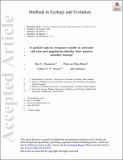Files in this item
A spatial capture-recapture model to estimate call rate and population density from passive acoustic surveys
Item metadata
| dc.contributor.author | Stevenson, Ben C. | |
| dc.contributor.author | van Dam-Bates, Paul | |
| dc.contributor.author | Young, Callum K.Y. | |
| dc.contributor.author | Measey, John | |
| dc.date.accessioned | 2021-11-30T00:36:28Z | |
| dc.date.available | 2021-11-30T00:36:28Z | |
| dc.date.issued | 2021-03 | |
| dc.identifier | 270957564 | |
| dc.identifier | 11fbf06e-16cf-42f5-a3f6-c1ff67b08896 | |
| dc.identifier | 85096939002 | |
| dc.identifier | 000594050100001 | |
| dc.identifier.citation | Stevenson , B C , van Dam-Bates , P , Young , C K Y & Measey , J 2021 , ' A spatial capture-recapture model to estimate call rate and population density from passive acoustic surveys ' , Methods in Ecology and Evolution , vol. 12 , no. 3 , pp. 432-442 . https://doi.org/10.1111/2041-210X.13522 | en |
| dc.identifier.issn | 2041-210X | |
| dc.identifier.other | RIS: urn:8949C14C0EFB6EB2D07B33E229814B07 | |
| dc.identifier.uri | https://hdl.handle.net/10023/24431 | |
| dc.description | This work was funded by an EPSRC/NERC PhD grant (No. EP/1000917/1), by the EPSRC through a Doctoral Fellowship Prize, and by the Royal Society of New Zealand through Marsden Grant 19-UOA-211. JM thanks the DSI-NRF Centre of Excellence for Invasion Biology. Funding for the frog survey was received from the National Geographic Society/Waitt Grants Program (No. W184-11). | en |
| dc.description.abstract | 1. Spatial capture‐recapture (SCR) models are commonly used to estimate animal population density from detections and subsequent redetections of individuals across space. In particular, acoustic SCR models deal with detections of animal vocalisations across an array of acoustic detectors. Previously published acoustic SCR methods either estimate call density (calls per unit space per unit time) rather than animal density itself, require an independently estimated call rate to estimate animal density, or discard data from all but one detected call from each individual. 2. In this manuscript, we develop a new spatial capture‐recapture model that estimates both call rate and animal density from the acoustic survey alone, without requiring an independently estimated call rate. Our approach therefore alleviates the need for the additional field work of physically locating and monitoring individual animals. We illustrate our method and compare it to an existing approach using a simulation study and an application to data collected on an acoustic survey of the visually cryptic Cape peninsula moss frog Arthroleptella lightfooti. 3. In the context of our acoustic survey, our calling animal density estimator has low bias, good precision, and confidence intervals with appropriate coverage, yielding results that are consistent with previous studies of the same species. 4. Our method can obtain accurate and precise estimates of animal density while eliminating the fieldwork burden associated with separately estimating call rate. We discuss how the development of our model’s likelihood reveals a clear path to further extensions, which may incorporate features such as animal movement processes and uncertain individual identification. | |
| dc.format.extent | 13007530 | |
| dc.language.iso | eng | |
| dc.relation.ispartof | Methods in Ecology and Evolution | en |
| dc.subject | Animal density | en |
| dc.subject | Anurans | en |
| dc.subject | Automated recording systems | en |
| dc.subject | Call density | en |
| dc.subject | Detection function | en |
| dc.subject | Passive acoustic monitoring | en |
| dc.subject | QH301 Biology | en |
| dc.subject | DAS | en |
| dc.subject | NIS | en |
| dc.subject.lcc | QH301 | en |
| dc.title | A spatial capture-recapture model to estimate call rate and population density from passive acoustic surveys | en |
| dc.type | Journal article | en |
| dc.contributor.institution | University of St Andrews. Statistics | en |
| dc.identifier.doi | https://doi.org/10.1111/2041-210X.13522 | |
| dc.description.status | Peer reviewed | en |
| dc.date.embargoedUntil | 2021-11-30 |
This item appears in the following Collection(s)
Items in the St Andrews Research Repository are protected by copyright, with all rights reserved, unless otherwise indicated.

